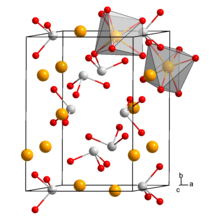
| |
| Identifiers | |
|---|---|
3D model (JSmol)
|
|
| ChemSpider | |
| ECHA InfoCard | 100.036.316 |
| EC Number |
|
PubChem CID
|
|
CompTox Dashboard (EPA)
|
|
| |
| |
| Properties | |
| CdO3Te | |
| Molar mass | 288.01 g·mol−1 |
| Appearance | colourless solid[1] |
| Melting point | 695 °C[1] |
| Boiling point | 1050 °C (decomposes)[1] |
| insoluble[2] | |
| Hazards | |
| GHS labelling:[3] | |

| |
| Warning | |
| H302, H312, H332 | |
| P261, P264, P270, P271, P280, P301+P317, P302+P352, P304+P340, P317, P321, P330, P362+P364, P501 | |
| Related compounds | |
Other anions
|
Cadmium telluride Cadmium tellurate Cadmium sulfite Cadmium selenite |
Other cations
|
Calcium tellurite Strontium tellurite Barium tellurite |
Except where otherwise noted, data are given for materials in their standard state (at 25 °C [77 °F], 100 kPa).
| |
Cadmium tellurite is the tellurite salt of cadmium, with the chemical formula CdTeO3.
Preparation
[edit]Cadmium tellurite can be prepared by the reaction of cadmium sulfate and sodium tellurite in ammonia.
Properties
[edit]Cadmium tellurite is a colourless solid[1] that is insoluble in water.[2] It is a semiconductor. It is part of the monoclinic crystal system, with space group P21/c (No. 14). It can also crystallize in the cubic crystal system and hexagonal crystal system at temperatures above 540 °C.[4][5]
References
[edit]- ^ a b c d William M. Haynes (2016). CRC Handbook of Chemistry and Physics. CRC Press. p. 53. ISBN 978-1-4987-5429-3.
- ^ a b Cadmium tellurite, 99% at AlfaAesar, accessed on {{{Datum}}} (PDF) (JavaScript required).[dead link]
- ^ "Cadmium tellurite". pubchem.ncbi.nlm.nih.gov.
- ^ Krämer, V.; Brandt, G. (1985-08-15). "Structure of cadmium tellurate(IV), CdTeO3". Acta Crystallographica Section C Crystal Structure Communications. 41 (8): 1152–1154. doi:10.1107/S0108270185006941.
- ^ Poupon, Morgane; Barrier, Nicolas; Petit, Sébastien; Boudin, Sophie (2017). "A new β-CdTeO 3 polymorph with a structure related to α-CdTeO 3". Dalton Transactions. 46 (6): 1927–1935. doi:10.1039/C6DT04449B. ISSN 1477-9226. PMID 28112302.
Well, that’s interesting to know that Psilotum nudum are known as whisk ferns. Psilotum nudum is the commoner species of the two. While the P. flaccidum is a rare species and is found in the tropical islands. Both the species are usually epiphytic in habit and grow upon tree ferns. These species may also be terrestrial and grow in humus or in the crevices of the rocks.
View the detailed Guide of Psilotum nudum: Detailed Study Of Psilotum Nudum (Whisk Fern), Classification, Anatomy, Reproduction